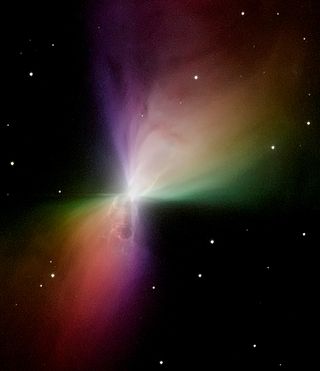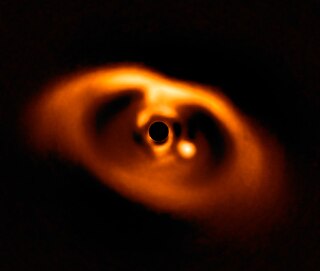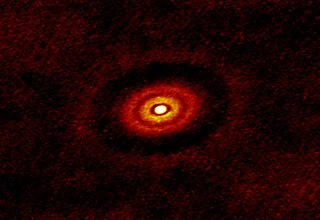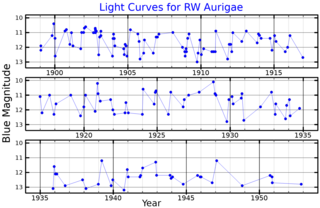Related Research Articles

Planetesimals are solid objects thought to exist in protoplanetary disks and debris disks. Believed to have formed in the Solar System about 4.6 billion years ago, they aid study of its formation.

The nebular hypothesis is the most widely accepted model in the field of cosmogony to explain the formation and evolution of the Solar System. It suggests the Solar System is formed from gas and dust orbiting the Sun which clumped up together to form the planets. The theory was developed by Immanuel Kant and published in his Universal Natural History and Theory of the Heavens (1755) and then modified in 1796 by Pierre Laplace. Originally applied to the Solar System, the process of planetary system formation is now thought to be at work throughout the universe. The widely accepted modern variant of the nebular theory is the solar nebular disk model (SNDM) or solar nebular model. It offered explanations for a variety of properties of the Solar System, including the nearly circular and coplanar orbits of the planets, and their motion in the same direction as the Sun's rotation. Some elements of the original nebular theory are echoed in modern theories of planetary formation, but most elements have been superseded.

A protoplanetary disk is a rotating circumstellar disc of dense gas and dust surrounding a young newly formed star, a T Tauri star, or Herbig Ae/Be star. The protoplanetary disk may also be considered an accretion disk for the star itself, because gases or other material may be falling from the inner edge of the disk onto the surface of the star. This process should not be confused with the accretion process thought to build up the planets themselves. Externally illuminated photo-evaporating protoplanetary disks are called proplyds.

A proplyd, short for ionized protoplanetary disk, is an externally illuminated photoevaporating protoplanetary disk around a young star. Nearly 180 proplyds have been discovered in the Orion Nebula. Images of proplyds in other star-forming regions are rare, while Orion is the only region with a large known sample due to its relative proximity to Earth.
Photoevaporation is the process where energetic radiation ionises gas and causes it to disperse away from the ionising source. The term is typically used in an astrophysical context where ultraviolet radiation from hot stars acts on clouds of material such as molecular clouds, protoplanetary disks, or planetary atmospheres.

In astrophysics, accretion is the accumulation of particles into a massive object by gravitationally attracting more matter, typically gaseous matter, into an accretion disk. Most astronomical objects, such as galaxies, stars, and planets, are formed by accretion processes.

A protoplanetary nebula or preplanetary nebula is an astronomical object which is at the short-lived episode during a star's rapid evolution between the late asymptotic giant branch (LAGB)[a] phase and the subsequent planetary nebula (PN) phase. A PPN emits strongly in infrared radiation, and is a kind of reflection nebula. It is the second-from-the-last high-luminosity evolution phase in the life cycle of intermediate-mass stars.

A bipolar outflow comprises two continuous flows of gas from the poles of a star. Bipolar outflows may be associated with protostars, or with evolved post-AGB stars.
HD 98800, also catalogued as TV Crateris, is a quadruple star system in the constellation of Crater. Parallax measurements made by the Hipparcos spacecraft put it at a distance of about 150 light-years away. The system is located within the TW Hydrae association (TWA), and has received the designation TWA 4.

The history of scientific thought about the formation and evolution of the Solar System began with the Copernican Revolution. The first recorded use of the term "Solar System" dates from 1704. Since the seventeenth century, philosophers and scientists have been forming hypotheses concerning the origins of our Solar System and the Moon and attempting to predict how the Solar System would change in the future. René Descartes was the first to hypothesize on the beginning of the Solar System; however, more scientists joined the discussion in the eighteenth century, forming the groundwork for later hypotheses on the topic. Later, particularly in the twentieth century, a variety of hypotheses began to build up, including the now-commonly accepted nebular hypothesis.
James Edward Pringle is a British astrophysicist. He is a professor of theoretical astronomy at the Institute of Astronomy, Cambridge part of the University of Cambridge.

An accretion disk is a structure formed by diffuse material in orbital motion around a massive central body. The central body is most frequently a star. Friction, uneven irradiance, magnetohydrodynamic effects, and other forces induce instabilities causing orbiting material in the disk to spiral inward toward the central body. Gravitational and frictional forces compress and raise the temperature of the material, causing the emission of electromagnetic radiation. The frequency range of that radiation depends on the central object's mass. Accretion disks of young stars and protostars radiate in the infrared; those around neutron stars and black holes in the X-ray part of the spectrum. The study of oscillation modes in accretion disks is referred to as diskoseismology.

A circumstellar disc is a torus, pancake or ring-shaped accretion disk of matter composed of gas, dust, planetesimals, asteroids, or collision fragments in orbit around a star. Around the youngest stars, they are the reservoirs of material out of which planets may form. Around mature stars, they indicate that planetesimal formation has taken place, and around white dwarfs, they indicate that planetary material survived the whole of stellar evolution. Such a disc can manifest itself in various ways.
In planetary science a streaming instability is a hypothetical mechanism for the formation of planetesimals in which the drag felt by solid particles orbiting in a gas disk leads to their spontaneous concentration into clumps which can gravitationally collapse. Small initial clumps increase the orbital velocity of the gas, slowing radial drift locally, leading to their growth as they are joined by faster drifting isolated particles. Massive filaments form that reach densities sufficient for the gravitational collapse into planetesimals the size of large asteroids, bypassing a number of barriers to the traditional formation mechanisms. The formation of streaming instabilities requires solids that are moderately coupled to the gas and a local solid to gas ratio of one or greater. The growth of solids large enough to become moderately coupled to the gas is more likely outside the ice line and in regions with limited turbulence. An initial concentration of solids with respect to the gas is necessary to suppress turbulence sufficiently to allow the solid to gas ratio to reach greater than one at the mid-plane. A wide variety of mechanisms to selectively remove gas or to concentrate solids have been proposed. In the inner Solar System the formation of streaming instabilities requires a greater initial concentration of solids or the growth of solid beyond the size of chondrules.

GG Tauri, often abbreviated as GG Tau, is a quintuple star system in the constellation Taurus. At a distance of about 450 light years away, it is located within the Taurus-Auriga Star Forming Region. The system comprises three stars orbiting each other in a hierarchical triple system, known as GG Tauri A, and another binary star system more distant from the central system, known as GG Tauri B.

PDS 70 is a very young T Tauri star in the constellation Centaurus. Located 370 light-years from Earth, it has a mass of 0.76 M☉ and is approximately 5.4 million years old. The star has a protoplanetary disk containing two nascent exoplanets, named PDS 70b and PDS 70c, which have been directly imaged by the European Southern Observatory's Very Large Telescope. PDS 70b was the first confirmed protoplanet to be directly imaged.

CI Tauri is a young star, about 2 million years old, located approximately 523 light-years away in the constellation Taurus. It is still accreting material from a debris disk at an unsteady pace, possibly modulated by the eccentric orbital motion of an inner planet. The spectral signatures of compounds of sulfur were detected from the disk.

A circumplanetary disk is a torus, pancake or ring-shaped accumulation of matter composed of gas, dust, planetesimals, asteroids or collision fragments in orbit around a planet. They are reservoirs of material out of which moons may form. Such a disk can manifest itself in various ways.

RW Aurigae is a young binary system in the constellation of Auriga about 530 light years away, belonging to the Taurus-Auriga association of the Taurus Molecular Cloud. RW Aurigae B was discovered in 1944.
James E. Owen is an astrophysicist at Imperial College London who studies exoplanets and accretion disks.
References
- 1 2 3 4 5 6 Glynn, Thomas (2017). "2017 Eddington Medal in Astronomy". www.staff.admin.cam.ac.uk. Retrieved 2018-10-19.
- 1 2 3 Clarke, Catherine Jane (1987). Accretion disc structure in binary star and galactic potentials. copac.jisc.ac.uk (DPhil thesis). University of Oxford. OCLC 499843339. EThOS uk.bl.ethos.376904.
- ↑ Anon. "Fellows of Clare College, Cambridge". www.clare.cam.ac.uk. Archived from the original on 2020-08-08. Retrieved 2018-10-19.
- ↑ "People at the Institute". 24 January 2023.
- ↑ Stamatellos, Dimitris; Goodwin, Simon; Ward-Thompson, Derek (2014). The Labyrinth of Star Formation. Springer Science & Business Media. doi:10.1007/978-3-319-03041-8. ISBN 9783319030418.
- ↑ "Hydrodynamical simulations of protoplanetary discs in the era of ALMA imaging | Projects | FP7-IDEAS-ERC | CORDIS | European Commission". CORDIS | European Commission. Retrieved 2018-10-19.
- ↑ Starkey, Isabel (2016-03-02). "All Prize Winners". www.cctl.cam.ac.uk. Archived from the original on 2019-04-11. Retrieved 2018-10-19.
- 1 2 3 Clarke, Cathie (2014). Principles of Astrophysical Fluid Dynamics. Cambridge: Cambridge University Press. doi:10.1017/CBO9780511813450. ISBN 9781107666917. OCLC 892455461.
- ↑ J., Clarke, Cathie (2015-09-11). Dynamics of young star clusters and associations : Saas-Fee advanced course 42. Mathieu, Robert D.,, Reid, I. Neill,, Schweizerische Gesellschaft für Astrophysik und Astronomie. Heidelberg. ISBN 9783662472903. OCLC 921176157.
{{cite book}}: CS1 maint: location missing publisher (link) CS1 maint: multiple names: authors list (link) - ↑ Haworth, Thomas J.; Facchini, Stefano; Clarke, Cathie J.; Cleeves, L. Ilsedore (2017). "First evidence of external disc photoevaporation in a low mass star forming region: the case of IM Lup". Monthly Notices of the Royal Astronomical Society: Letters. 468 (1): L108–L112. arXiv: 1703.03409 . Bibcode:2017MNRAS.468L.108H. doi: 10.1093/mnrasl/slx037 . ISSN 1745-3925. S2CID 56215417.
- ↑ "Giant planets around young star raise questions about how planets form". University of Cambridge. 2018-10-15. Retrieved 2018-10-19.
- 1 2 3 Clarke, C. J.; Tazzari, M.; Juhasz, A.; Rosotti, G.; Booth, R.; Facchini, S.; Ilee, J. D.; Johns-Krull, C. M.; M. Kama (2018). "High-resolution Millimeter Imaging of the CI Tau Protoplanetary Disk: A Massive Ensemble of Protoplanets from 0.1 to 100 au". The Astrophysical Journal Letters. 866 (1): L6. arXiv: 1809.08147 . Bibcode:2018ApJ...866L...6C. doi: 10.3847/2041-8213/aae36b . ISSN 2041-8205. S2CID 119042020.
- ↑ "Talks, Colloquia". www.physik.uni-heidelberg.de. Retrieved 2018-10-19.
- ↑ Haworth, Thomas J; Facchini, Stefano; Clarke, Cathie J; Mohanty, Subhanjoy (2018). "Where can a Trappist-1 planetary system be produced?". Monthly Notices of the Royal Astronomical Society. 475 (4): 5460–5473. arXiv: 1801.05822 . Bibcode:2018MNRAS.475.5460H. doi: 10.1093/mnras/sty168 . ISSN 0035-8711. S2CID 119460112.
- ↑ "Cathie Clarke". www.journals.elsevier.com. Retrieved 2018-10-19.
- ↑ "Cathie Clarke". royalsociety.org. Retrieved 2023-05-24.